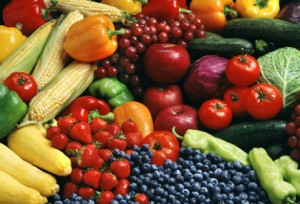Naturopathic Nutrition: Healthy Foods
What could be more appetizing than a meal full of rainbow colours? Salads of bright green leaves and vibrant red tomatoes, red onion rings, yellow peppers, garnishes of sliced oranges and grated carrot? Red, purple, blue and yellow fruits and berries?
 Like bees, drawn to the pretty colours of flowers, humans too are drawn to intense colours when we eat. There is good reason for this. The colours themselves are nutrients – flavonoids and carotenes with powerful antioxidant properties, some of them twenty times more powerful than vitamin E. Antioxidants are our main protection against most killer diseases, and are responsible for many successes using naturopathic nutrition treatments. A large number of scientific studies now show that if you are a regular consumer of fruit and veg you will have only half the chances of getting cancer or heart disease compared with those at the opposite end of the scale.
Like bees, drawn to the pretty colours of flowers, humans too are drawn to intense colours when we eat. There is good reason for this. The colours themselves are nutrients – flavonoids and carotenes with powerful antioxidant properties, some of them twenty times more powerful than vitamin E. Antioxidants are our main protection against most killer diseases, and are responsible for many successes using naturopathic nutrition treatments. A large number of scientific studies now show that if you are a regular consumer of fruit and veg you will have only half the chances of getting cancer or heart disease compared with those at the opposite end of the scale.
Blue and purple
Scientists used to think that this was just because of the vitamins in these foods. Now they know it is the colours themselves. In fact, so important are they in disease prevention that the US Department of Agriculture awarded a research grant to Washington geneticist Dr Charles Brown to develop a ‘purple potato’ as a functional food. Potato varieties with red or purple flesh already exist, and have antioxidant capacities 2-3 times greater than white varieties. The purple colour is due to a flavonoid known as anthocyanin, which literally means ‘flower blue’ as it is also found in flowers.
More than 300 different types of anthocyanins have been identified in nature – all with a slightly different chemical structure. Anthocyanin doesn’t always look blue. It changes colour depending on whether the plant’s sap is neutral, acid or alkaline, and it is responsible for the red, blue or purple hue of strawberries, cherries, cranberries, raspberries, bilberries, blueberries, blackberries, grapes (including red wine) and blackcurrants, among other foods.
Anthocyanin has powerful health benefits – so much so that bilberry, grape or cherry skin extracts are sold as food supplements or added to vitamin C products. Bilberries, for example, have long been used for improving eyesight and treating circulatory problems; this is because anthocyanin helps to keep the walls of tiny blood vessels strong and healthy, thus improving the circulation and bringing more oxygen and nutrients to delicate tissues such as eyes and ears. People with weak blood vessels – i.e. people who bruise easily or suffer from varicose veins – are often lacking in flavonoids.
The Linus Pauling Institute in the USA, which specializes in vitamin C research, is collecting growing experimental evidence that anthocyanin and other flavonoids also have anti-inflammatory, antiviral and antibacterial properties. Writing on the Institute’s website, researcher Ronald E. Wrolstad PhD suggests that one day there will be an RDA (recommended daily amount) for these dietary antioxidants, just as there is now for vitamins and minerals.
Yellow
Another type of flavonoid – this time with a yellowish colour – is known as the isoflavone. It is found in beans and other pulses, especially the soy bean. Two well-known isoflavones are genistein and daidzein, ‘plant oestrogens’ with a pronounced anti-prostate cancer effect. Plant oestrogens are not actually hormones – just a type of flavonoid which can interact with or balance our hormonal system.
Health-wise, one of the most important yellow colours in food is curcumin, found in the Indian kitchen spice turmeric. Turmeric is widely used in India to treat arthritis and liver problems. This makes good sense as we now know it is a very powerful antioxidant with the ability to combat liver inflammation and boost levels of glutathione. Glutathione is an amino acid made within the body and is one of our most potent defences against cancer, pollutants and viruses.
Turmeric can also boost the flow of bile, the liver’s waste product, and so helps to drain and flush out the liver. In India it is used as an ingredient in curries, or cooked into a paste with water and then rolled into balls and swallowed as a medicine. Its cheapness is a great advantage.
Orange and red
One very well-known family of yellow, orange and red colours is the carotene family, which includes alpha- and beta-carotene, lycopene and lutein. Below you can see the foods to which they give colour. The yellow of carotenes in leafy greens and broccoli is usually masked by the green colour of chlorophyll, but as the leaves age and the green fades, the carotene starts to show through.
The health benefits of carotenes are mainly due to their antioxidant properties, but alpha- and beta-carotenes have the added benefit that your body can convert them to vitamin A. The red colour lycopene, found mainly in tomatoes, can slow down the growth rate of cancer cells and is especially good at preventing both breast and prostate cancer. The Italian diet, with its high proportion of tomatoes and especially tomato purée (paste), is very rich in lycopene. The darker the red of tomatoes, the more lycopene they contain. Tomatoes ripened on the vine also contain more lycopene than those left to ripen after picking.
Lutein has an affinity for the eyes, and a leutein-rich diet helps to reduce the risk of macular degeneration, a leading cause of blindness. Kale is the richest source, providing six times as much lutein as the next best sources, broccoli and lettuce. The lutein from vegetables seems to be better absorbed when they are juiced rather than eaten whole.
In this polluted world, our bodies need naturopathic nutrition. Don’t forget to eat those five portions a day of fruit and vegetables recommended by the World Health Organization – and to choose varieties with the brightest, deepest natural colours that you can. The easiest way to get them into your diet is to make home-made vegetable soup, and to start each meal with a large bowlful. Or turn them into juice with a juice extractor and drink them! Broccoli and carrots are especially suitable for juicing. Don’t forget to make vegetable curry from time to time, coloured with a liberal dose of turmeric.
Make a brightly-coloured salad to go with each meal, using tomatoes, lettuce, red cabbage and brightly-coloured peppers. Consume as many different fruits and their juices as you can, especially prunes, raisins, blackcurrants, blackberries, black cherries and bilberries. Freeze them so that you will have a supply for winter too. Frozen berries braised in red wine make a delicious dessert. Use prunes and dark raisins to sweeten them – rainbow nutrients are even more concentrated in dried fruit.
There may come a day when we will all be eating purple fries, but in the meantime why not increase the carotene content of your meal by adding some mashed carrots, orange sweet potatoes or butternut squash to ordinary mashed potatoes? And don’t forget the parsley!
Naturopathic nutrition: the main colours and their best sources
Anthocyanin (blue, red, violet)
Found in strawberries, cherries, cranberries, raspberries, bilberries, blueberries, black cherries, blackberries, black grapes (including red wine), blackcurrants
Isoflavones (pale yellow)
Isoflavones are very common. Various types are found in a large variety of foods, including wheat, oats, carrots, sage leaves, hops, olive oil.
Soya products contain the isoflavones genistein and daidzein
Curcumin (deep yellow)
Found in turmeric
Carotenes (red, yellow, orange)
Alpha carotene: found in carrots, red and yellow peppers, pumpkin
Beta carotene: found in carrots, apricots, canteloupe, parsley, spinach, kale, sweet potatoes
Lutein: found in kale, spinach, lettuce, parsley, broccoli
Lycopene: found in tomatoes, pink grapefruit, guava, watermelon
Top antioxidant foods
Antioxidant score per 100 grams
(Source, University of California Berkeley Wellness Letter, November 1999)
Fruits
Prunes 5770
Raisins 2830
Blueberries 2400
Strawberries 1540
Raspberries 1220
Plums 949
Oranges 750
Red grapes 739
Cherries 670
Vegetables
Kale 1770
Spinach 1260
Brussels sprouts 980
Broccoli florets 890
Beetroot 840
Sweet red peppers 710
Maize 400
Aubergine 390
Carrots 210
Study Naturopathic Nutrition
Copyright School of Modern Naturopathy 2011

